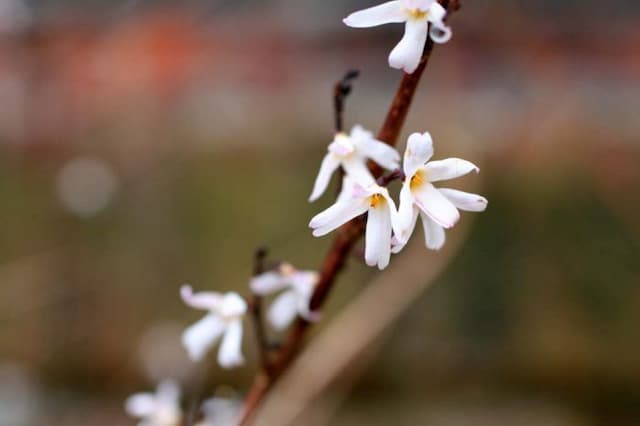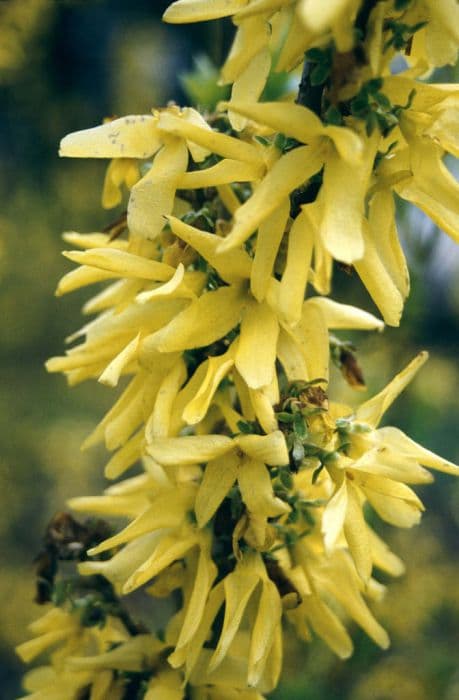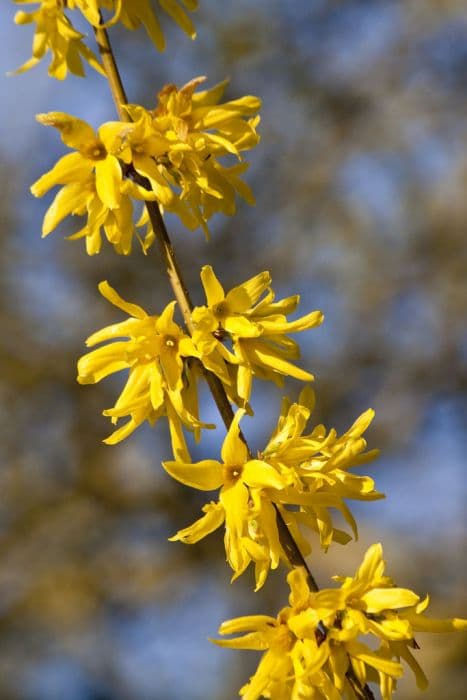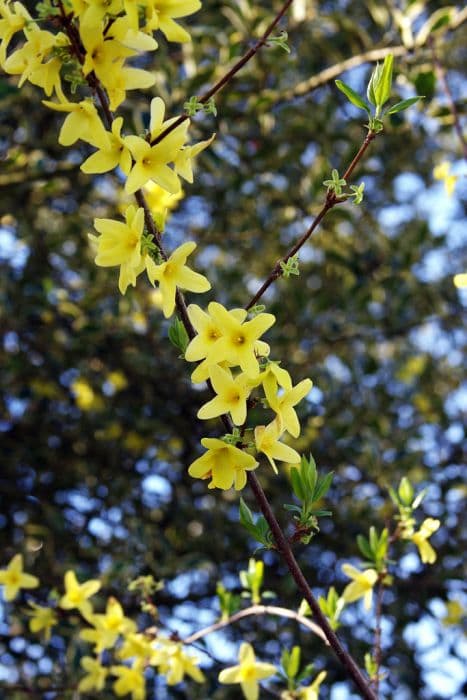California privet Ligustrum ovalifolium
ABOUT
Ligustrum ovalifolium is a vigorous, upright glossy green ,oval-leaved bushy shrub. It is commonly used as 'privet' hedging, but left unpruned becomes a shaggy tree. Small white fragrant flowers in pointed clusters appear between June and July, which are highly attractive to bees. Round black berry fruits are borne in autumn.
About this plant
 Names
NamesSynonyms
California Privet, Oval-Leaf Privet, Oval-Leaved Privet, Japanese Privet, Evergreen Ligustrum, Garden Privet
Common names
Ligustrum obtusifolium var. ovalifolium, Ligustrum ovalifolium var. aureum, Ligustrum ovalifolium f. aureovariegatum, Ligustrum ovalifolium f. crispifolium, Ligustrum ovalifolium f. dentatum, Ligustrum ovalifolium f. variegatum.
 Characteristics
CharacteristicsLife cycle
Perennials
Foliage type
Evergreen
Color of leaves
Green
Flower color
White
Height
10-15 feet (3-4.5 meters)
Spread
10-15 feet (3-4.5 meters)
Plant type
Shrub
Hardiness zones
5-8
Native area
Japan Korea
Benefits
 General Benefits
General Benefits- Easy to cultivate: Ligustrum ovalifolium, commonly known as California privet, is highly adaptable and can thrive in a wide range of soil types and conditions.
- Fast growth: California privet is known for its rapid growth rate, making it an excellent choice for quickly establishing hedges and privacy screens.
- Pruning tolerance: It responds well to pruning and shaping, which is ideal for creating structured garden designs and topiaries.
- Drought tolerance: Once established, California privet can tolerate periods of drought, reducing the need for frequent watering.
- Dense foliage: The plant has dense foliage, which is effective for creating privacy barriers and reducing noise pollution.
- Ornamental berries: It produces attractive berries that can add visual interest to the landscape, though they should be noted as potentially invasive and harmful if ingested.
- Seasonal interest: California privet offers seasonal interest with its white flowers in summer and semi-evergreen leaves that can provide color in milder winters.
 Medical Properties
Medical PropertiesThis plant is not used for medical purposes.
 Air-purifying Qualities
Air-purifying QualitiesThis plant is not specifically known for air purifying qualities.
 Other Uses
Other Uses- Ligustrum ovalifolium, commonly known as the California privet, can be used to create intricate topiary sculptures in formal gardens due to its dense growth and easy trimming characteristics.
- The wood of California privet is hard and can be used for making small turned items such as spindles or tool handles, showcasing its utility in fine woodworking.
- Because of its dense foliage, the California privet is often planted as a windbreak in coastal areas, helping to protect more vulnerable plants from harsh sea breezes.
- In rural settings, the plant has been used to stabilize soil on steep embankments, thus playing a role in erosion control.
- California privet's dense thickets provide shelter and nesting sites for urban wildlife and birds, supporting biodiversity within city landscapes.
- The glossy leaves of California privet have been used in floral arrangements and bouquets to add a touch of greenery and structure to the composition.
- The berries of the California privet, though poisonous to humans, can be used to make dyes for fabrics, providing a natural coloring option.
- While not suited for consumption, dried and crushed leaves of California privet can be used as an organic mulch, providing nutrients and moisture retention to the soil.
- California privet can be planted in large pots to create privacy screens on balconies and terraces in urban environments.
- The plant has been used in educational settings, such as biology classes, to teach students about plant growth, taxonomy, and ecology.
Interesting Facts
 Feng Shui
Feng ShuiThe California privet is not used in Feng Shui practice.
 Zodiac Sign Compitability
Zodiac Sign CompitabilityThe California privet is not used in astrology practice.
 Plant Symbolism
Plant Symbolism- Privet Hedge: The most common common name for Ligustrum ovalifolium is "Privet Hedge." It often symbolizes privacy and boundaries because of its usage in creating living fences and screens, representing the delineation of personal or private spaces.
- Resilience: Privet Hedge is known for its hardiness and ability to thrive in various conditions, which makes it a symbol of resilience and adaptability.
- Regrowth: Given its vigorous growth and ability to recover from pruning, the Privet Hedge symbolizes regeneration and new beginnings.
- Invasiveness: In some areas where it has become invasive, it may symbolize overgrowth or loss of control, as it can dominate landscapes and outcompete native flora.
 Water
WaterThe California Privet, or Ligustrum ovalifolium, should be watered deeply and less frequently to encourage strong root development. During the growing season, it typically needs watering once a week, but this may vary depending on climate conditions, such as heat and drought. To ensure adequate hydration, apply about 1-2 gallons of water to the root zone each time, depending on the size and maturity of the plant. During the winter months, reduce watering to every other week or less, as the plant will not require as much moisture. Always check the soil moisture before watering to avoid overwatering, which can lead to root rot.
 Light
LightThe California Privet thrives in full sun to partial shade conditions. The ideal location for this plant is a spot that receives at least four to six hours of direct sunlight daily, though it can tolerate some shade, especially in the afternoon. It is adaptable to different light conditions but grows more densely and is healthier when given ample sunlight.
 Temperature
TemperatureThe California Privet is hardy in a range of temperatures and can survive minimum temperatures down to about -10 to -15 degrees Fahrenheit. It can handle the heat well, but its ideal growing conditions are in areas where the average temperature is between 40 and 80 degrees Fahrenheit. Extreme temperatures outside of the minimum and maximum range might harm the plant or stunt its growth.
 Pruning
PruningPruning the California Privet promotes dense, bushy growth and maintains the desired shape. Prune in late winter or early spring before new growth starts. Because it grows rapidly, you might need to prune it again in the summer to keep its shape. Pruning is also necessary to remove any dead or diseased branches, which helps maintain the plant's health and appearance.
 Cleaning
CleaningAs needed
 Soil
SoilFor California privet (Ligustrum ovalifolium), a well-draining loamy soil mix is ideal, incorporating organic matter like compost. It thrives in a broad pH range, typically between 5.5 and 7.5.
 Repotting
RepottingCalifornia privet should be repotted every 2-3 years or when rootbound; usually in early spring before the onset of new growth.
 Humidity & Misting
Humidity & MistingCalifornia privet tolerates a wide range of humidity levels and is quite adaptable but prefers average to high humidity environments.
 Suitable locations
Suitable locationsIndoor
Place in bright, indirect light; water regularly.
Outdoor
Plant in well-drained soil; full sun to partial shade.
Hardiness zone
5-8 USDA
 Life cycle
Life cycleCalifornia privet (Ligustrum ovalifolium) begins its life cycle as a seed, which, after dispersal, germinates in favorable soil conditions—usually in spring. The seedling emerges and begins vegetative growth, developing a root system and foliage as it becomes a sapling. As it matures into an adult shrub, it undergoes vegetative expansion with leaves, branches, and a more extensive root system. During the summer, it reaches the reproductive stage, producing clusters of small, white, fragrant flowers that are attractive to pollinators. Following pollination, flowers develop into small, oval, dark-colored berries, which contain the seeds for the next generation. The plant then goes into a dormant phase during the colder months, conserving energy until the cycle begins anew with warming temperatures.
 Propogation
PropogationPropogation time
Spring-Early Summer
The California privet (Ligustrum ovalifolium) is commonly propagated through semi-hardwood cuttings. This method usually takes place in the late summer. You should select healthy, mature stems from the current year's growth and cut segments around 4 to 6 inches (10 to 15 cm) long. Each cutting should have several leaf nodes, and the leaves on the lower half should be removed. The cut end can be dipped in rooting hormone to encourage root growth and then planted in a well-draining potting mix. Maintaining a humid environment by covering the cuttings with a plastic bag or placing them in a greenhouse can improve the chances of success. The cuttings typically root in several weeks, after which they can be gradually acclimated to less humid conditions and eventually planted out.








